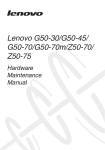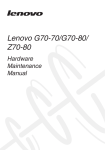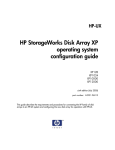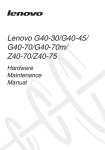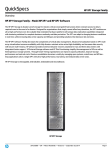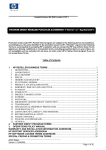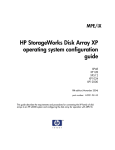Download HP SVS200 Owner's Manual
Transcript
HP StorageWorks 200 Storage Virtualization System owner’s guide This guide describes features, components, options, and general operations for the HP StorageWorks 200 Storage Virtualization System (SVS200). Part number: AE071-96004 Second edition: October 2006 Legal and notice information © Copyright 2006 Hewlett-Packard Development Company, L.P., all rights reserved. Confidential computer software. Valid license from HP required for possession, use or copying. Consistent with FAR 12.211 and 12.212, Commercial Computer Software, Computer Software Documentation, and Technical Data for Commercial Items are licensed to the U.S. Government under vendor’s standard commercial license. The information contained herein is subject to change without notice. The only warranties for HP products and services are set forth in the express warranty statements accompanying such products and services. Nothing herein should be construed as constituting an additional warranty. HP shall not be liable for technical or editorial errors or omissions contained herein. Intel, Itanium, Pentium, Intel Inside, and the Intel Inside logo are trademarks or registered trademarks of Intel Corporation or its subsidiaries in the United States and other countries. Microsoft, Windows, Windows XP, and Windows NT are U.S. registered trademarks of Microsoft Corporation. Adobe and Acrobat are trademarks of Adobe Systems Incorporated. Java is a U.S. trademark of Sun Microsystems, Inc. Oracle is a registered U.S. trademark of Oracle Corporation, Redwood City, California. Linux is a U.S. registered trademark of Linus Torvalds. UNIX is a registered trademark of The Open Group. Printed in the U.S. Contents Preface . . . . . . . . . . . . . . . . . . . . . . . . . About this guide . . . . . . . . . Intended audience . . . . . . . . HP SVS200 . . . . . . . . . . . Related documentation . . . . . . Document conventions and symbols Rack stability . . . . . . . . . . HP technical support . . . . . . . Subscription service . . . . . . . HP web sites . . . . . . . . . . Documentation feedback . . . . . . . . . . . . . . . . . . . . . . . . . . . . . . . . . . . . . . . . . . . . . . . . . . . . . . . . . . . . . . . . . . . . . . . . . . . . . . . . . . . . . . . . . . . . . . . . . . . . . . . . . . . . . . . . . . . . . . . . . . . . . . . . . . . . . . . . . . . . . . . . . . . . . . . . . . . . . . . . . . . . . . . . . . . . . . . . . . . . . . . . . . . . . . . . . . . . . . . . . . . . . . . . . . . . . . . 1 Overview . . . . . . . . . . . . . . . . . . . . . . 2 Hardware . . . . . . . . . . . . . . . . . . . . . . HP SVS200 description . . . . . . . . . One Controller for multiple storage systems Connectivity . . . . . . . . . . . . . Scalability . . . . . . . . . . . . . . Dual Controller option . . . . . . . High availability . . . . . . . . . . . . Summary of features . . . . . . . . . . Web-based storage management . . Operating systems . . . . . . . . . External storage . . . . . . . . . . Included components . . . . . . . . Optional components . . . . . . . Hardware specifications . . . . . . Physical components . . . . . . . . Controller . . . . . . . . . . . . . Control panel . . . . . . . . . Service processor (SVP) . . . . . HP StorageWorks Continuous Track Backup batteries . . . . . . . . . . System and storage management . . Operating specifications . . . . . . Temperature . . . . . . . . . . . . . . . . . XP . . . . . . . . . . . . . . . . . . . . . . . . . . . . . . . . . . . . . . . . . . . . . . . . . . . . . . . . . . . . . . . . . . . . . . . . . . . . . . . . . . . . . . . . . . . . . . . . . . . . . . . . . . . . . . . . . . . . . . . . . . . . . . . . . . . . . . . . . . . . . . . . . . . . . . . . . . . . . . . . . . . . . . . . . . . . . . . . . . . . . . . . . . . . . . . . . . . . . . . . . . . . . . . . . . . . . . . . . . . . . . . . . . . . . . . . . . . . . . . . . . . . . . . . . . . . . . . . . . . . . . . . . . . . . . . . . . . . . . . . . . . . . . . . . . . . . . . . . . . . . . . . . . . . . . . . . . . . . . . . . . . . . . . . . . . . . . . . . . . . . . . . . . . . . . . . . . . . . . . . . . . . . . . . . . . . . . . . . . . . . . . . . . . . . . . . . . . . . . . . . . . . HP StorageWorks 200 Storage Virtualization System owner’s guide . . . . . . . . . . . . . . . . . . . . . . . . . . . . . . . . . . . . . . . . . . 6 6 6 6 6 7 8 8 9 9 9 11 12 14 14 14 15 16 17 17 17 17 18 18 19 21 21 24 24 28 28 29 30 31 31 3 Humidity . . . . . . . . . . . . . . . . . . . . . . . . . . . . . . . . Mechanical vibration . . . . . . . . . . . . . . . . . . . . . . . . . . . AC line voltage requirements . . . . . . . . . . . . . . . . . . . . . . . 3 Operations . . . . . . . . . . . . . . . . . . . . . . General safety guidelines . . . . . . . . . . . . . . . Powering down the system . . . . . . . . . . . . . . Emergency power off . . . . . . . . . . . . . . . Planned power off . . . . . . . . . . . . . . . . Recovering from an unplanned or emergency power outage Manual restart after power is restored . . . . . . . . To restart the system manually: . . . . . . . . . Automatic restart when power is restored . . . . . . . . . . . . . . . . . . . . . . . . . . . . . . . . . . . . . . . . . . . . . . . . . . . . . . . . . . . . . . . . . . . . . . . . . . . . . . . . . . . . . . . . . . . . . . 4 Software . . . . . . . . . . . . . . . . . . . . . . . Available software products . . . . . . . . . . . . HP LUN Configuration and Security Manager . . . . HP Cache LUN . . . . . . . . . . . . . . . . . HP Data Integrity Check . . . . . . . . . . . . . HP LUN Security Extension . . . . . . . . . . . . HP External Storage . . . . . . . . . . . . . . . HP Command View XP Advanced Edition (AE) . . . . HP Tiered Storage Manager . . . . . . . . . . . . HP StorageWorks Business Copy and HP Snapshot XP HP StorageWorks Continuous Access Synchronous and Asynchronous . . . . . . . . . . . . . . . . . . HP StorageWorks XP Disk/Cache Partition . . . . . . . . . . . . . . . . . . . . . . . . . . . . . . . . . . . . . . . . . . . . . . . . . . . . . . . . . . . . . . . . . . . . . . . . . . . . . . . . . . . . . . . . . . . . . . . . HP Continuous Access . . . . . . . . . . . . . . . . . . . . . . . . . . . . . . . . . . . . . . . . . . . . . . . . . . . . . . . . . . . . . . . . . . . . . . . . 5 Troubleshooting . . . . . . . . . . . . . . . . . . . . Service information messages . . . . . . . . . . . . . . . . . . . . . . . . . Failure detection and reporting process . . . . . . . . . . . . . . . . . . . . . 6 Regulatory statements . . . . . . . . . . . . . . . . . FCC EMC statement (USA) . . . IEC statement (worldwide) . . . . EMC statement (Canada) . . . . Spécification ATI Classe A (France) VCCI EMC statement (Japan) . . BSMI EMC statement (Taiwan) . . RRL EMC statement (Korea) . . . Harmonics conformance (Japan) . German noise declaration . . . Japan DENAN law cordset caution Laser safety . . . . . . . . . . 4 . . . . . . . . . . . . . . . . . . . . . . . . . . . . . . . . . . . . . . . . . . . . . . . . . . . . . . . . . . . . . . . . . . . . . . . . . . . . . . . . . . . . . . . . . . . . . . . . . . . . . . . . . . . . . . . . . . . . . . . . . . . . . . . . . . . . . . . . . . . . . . . . . . . . . . . . . . . . . . . . . . . . . . . . . . . . . . . . . . . . . . . . . . . . . . . . . . . . . . . . . . . . . . . . . . . . . . . . . . . . . . . . . . . . . . . . . . . . . . . . . . . . . . . . . . . . . 32 32 33 35 36 38 38 39 40 40 40 42 43 44 45 45 46 46 47 47 48 49 49 49 51 51 52 53 53 53 53 54 54 54 54 55 55 55 56 European WEEE statements . . . . . . . . . . . . . . . . . . . . . . . . . . 57 Glossary . . . . . . . . . . . . . . . . . . . . . . . . 65 Index . . . . . . . . . . . . . . . . . . . . . . . . . 71 HP StorageWorks 200 Storage Virtualization System owner’s guide 5 Preface About this guide This guide provides information about owning and operating the HP 200 Storage Virtualization System. Intended audience This guide is intended for system administrators with knowledge of: • the host hardware • the operating system • RAID technology HP SVS200 Unless otherwise noted, the term HP SVS200 refers to the HP StorageWorks 200 Storage Virtualization System. Related documentation The following documents provide related information: • • • • HP HP HP HP StorageWorks StorageWorks StorageWorks StorageWorks 200 Storage Virtualization System site preparation guide LUN Configuration and Security Manager user guide Command View XP Advanced Edition user guide Disk Array XP Operating System configuration guide You can find these documents from the Manuals page of the HP Business Support Center web site: http://www.hp.com/support/manuals. In the Storage section, click Storage array systems and then select your product. 6 Preface Document conventions and symbols Convention Element Blue text: Document conventions and symbols Cross-reference links and e-mail addresses Blue, underlined text: http://www.hp.com Web site addresses Bold text • Keys that are pressed • Text typed into a GUI element, such as a box • GUI elements that are clicked or selected, such as menu and list items, buttons, tabs, and check boxes Italic text Text emphasis Monospace text • • • • Monospace, italic text • Code variables • Command variables Monospace, bold text Emphasized monospace text File and directory names System output Code Commands, their arguments, and argument values WARNING! Indicates that failure to follow directions could result in bodily harm or death. CAUTION: Indicates that failure to follow directions could result in damage to equipment or data. IMPORTANT: Provides clarifying information or specific instructions. NOTE: Provides additional information. HP StorageWorks 200 Storage Virtualization System owner’s guide 7 TIP: Provides helpful hints and shortcuts. Rack stability Rack stability protects personnel and equipment. WARNING! To • • • • • reduce the risk of personal injury or damage to equipment: Extend leveling jacks to the floor. Ensure that the full weight of the rack rests on the leveling jacks. Install stabilizing feet on the rack. In multiple-rack installations, fasten racks together securely. Extend only one rack component at a time. Racks can become unstable if more than one component is extended. HP technical support Telephone numbers for worldwide technical support are listed on the HP support web site: http://www.hp.com/support/. Collect the following information before calling: • • • • • • Technical support registration number (if applicable) Product serial numbers Product model names and numbers Error messages Operating system type and revision level Detailed questions For continuous quality improvement, calls may be recorded or monitored. 8 Preface Subscription service HP strongly recommends that customers register online using the Subscriber’s Choice web site: http://www.hp.com/go/e-updates. Subscribing to this service provides you with e-mail updates on the latest product enhancements, newest driver versions, and firmware documentation updates as well as instant access to numerous other product resources. After subscribing, locate your products by selecting Business support and then Storage under Product Category. HP web sites For additional information, see the following HP web sites: • • • • • http://www.hp.com http://www.hp.com/go/storage http://www.hp.com/service_locator http://www.hp.com/support/manuals http://www.hp.com/support/downloads Documentation feedback HP welcomes your feedback. To make comments and suggestions about product documentation, please send a message to [email protected]. All submissions become the property of HP. HP StorageWorks 200 Storage Virtualization System owner’s guide 9 10 Preface 1 Overview The HP SVS200 is an addition to the StorageWorks family of storage and storage management products. It provides unified control of multiple storage systems made by HP and other manufacturers. The HP SVS200 supports multiple operating systems, platforms, and RAID groups. Advantages of the HP SVS200 system include: • • • • One GUI and controller manages multiple storage systems Connectivity Scalability Ease of use and management HP StorageWorks 200 Storage Virtualization System owner’s guide 11 HP SVS200 description The following figure and text describe the HP SVS200 system. 12 Overview Item Component Description 1 Front view Front view of rack with cabinet open 2 SVS200 Controller Controller, including modules, control panel, and Service Processor PC (SVP) 3 Second Controller space Space where a second factory-installed SVS200 Controller resides if you ordered a second unit with this rack. 4 Control Panel Operational controls (described later) CAUTION: The HP SVS200 has no user-serviceable components. Only an HP support representative should open the cabinet. HP StorageWorks 200 Storage Virtualization System owner’s guide 13 One Controller for multiple storage systems One control unit and GUI for unified storage management: • Controls multiple heterogeneous arrays • Manages multiple SAN fabrics with large port counts located on multiple sites • Allows continued storage growth managed by a single storage virtualization system, saving training and administration costs • Enables optimum use of tiered storage, allowing automated placement of critical data on premium, highly available storage, less critical data on low cost storage, and migration of data from legacy systems to newer systems • Simplifies management of virtual volumes, dynamically reallocating capacity and pooling heterogeneous volumes into a single reservoir to increase capacity utilization • Provides local and remote heterogeneous data replication for data distribution, data mining, backup and restore, and data validation testing Connectivity The system can be configured to provide the following types of host connections: • Fibre Channel: Open Systems; FC-AL or Fabric; 1, 2, or 4 Gbps, single or multimode; LC-Duplex Scalability The HP SVS200 scales to fit your current and future storage capacity needs. The system consists of one primary 19-inch equipment rack containing one or two factory-installed controller units. The controller can be equipped with the following hardware and software bundles based on the maximum storage to be managed: • 1 TB Bundle: Hardware to control up to 1 TB of storage, including controller and rack, CHIP pair, 4 GB cache, and 2 GB shared memory. Software to control up to 1 TB of storage, including HP SVS200 LUN Configuration and Security Manager, HP Command View XP Advanced Edition, HP SVS200 Tiered Storage Manager, HP Data Integrity Check, HP SVS200 External Storage, and HP Disk/Cache Partition. • 6 TB Bundle: Hardware to control up to 6 TB of storage, including controller and rack, CHIP pair, 12 GB cache, and 2 GB shared memory. Software to control up to 6 TB of storage, including HP SVS200 LUN Configuration and Security Manager, HP Command View XP Advanced Edition, HP SVS200 Tiered Storage 14 Overview • • • • Manager, HP Data Integrity Check, HP SVS200 External Storage, and HP Disk/Cache Partition. 16 TB Bundle: Hardware to control up to 16 TB of storage, including controller and rack, CHIP pair, 16 GB cache, 2 GB shared memory, and 1 battery. Software to control up to 16 TB of storage, including HP SVS200 LUN Configuration and Security Manager, HP Command View XP Advanced Edition, HP SVS200 Tiered Storage Manager, HP Data Integrity Check, HP SVS200 External Storage, and HP Disk/Cache Partition. 32 TB Bundle: Hardware to control up to 32 TB of storage, including controller and rack, CHIP pair, 24 GB cache, 2 GB shared memory, and 1 battery. Software to control up to 32 TB of storage, including HP SVS200 LUN Configuration and Security Manager, HP Command View XP Advanced Edition, HP SVS200 Tiered Storage Manager, HP Data Integrity Check, HP SVS200 External Storage, and HP Disk/Cache Partition. 64 TB Bundle: Hardware to control up to 64 TB of storage, including controller and rack, CHIP pair, 24 GB cache, 2 GB shared memory, and 1 battery. Software to control up to 64 TB of storage, including HP SVS200 LUN Configuration and Security Manager, HP Command View XP Advanced Edition, HP SVS200 Tiered Storage Manager, HP Data Integrity Check, HP SVS200 External Storage, and HP Disk/Cache Partition. >64 TB Bundle: Hardware to control up to 127 TB of storage, including controller and rack, CHIP pair, 24 GB cache, 2 GB shared memory, and 1 battery. Software to control up to 127 TB of storage, including HP SVS200 LUN Configuration and Security Manager, HP Command View XP Advanced Edition, HP SVS200 Tiered Storage Manager, HP Data Integrity Check, HP SVS200 External Storage, and HP Disk/Cache Partition. Dual Controller option The system you order can include a second factory-installed controller with the bundled options listed previously. HP StorageWorks 200 Storage Virtualization System owner’s guide 15 High availability To provide high levels of availability, the HP SVS200 contains redundant hardware, including: • • • • • • Mirrored write cache Dual channel adapters (CHIP pairs) Dual and concurrently active data and control paths Split power domains Hot-pluggable boards, fans, and power supplies Online upgradable firmware The following software features and products help to ensure that the system meets your requirements for high availability: • Capability to “phone home” to the multidisciplinary HP Storage Technology Center (STC) using HP StorageWorks Continuous Track XP • Advanced remote diagnostics • Full solution (host-SAN-storage) support • Full software and solution integration enabled by HP software products. See “Chapter 4 Software” for details. 16 Overview Summary of features This section summarizes the features and specifications of the system. For the most current product information, visit the HP web site: http://h18006.www1.hp.com/ storage/enterprisestorage.html. Web-based storage management The storage virtualization system comes with HP StorageWorks Command View Advanced Edition, a browser-based interface that runs on a single Windows-based Device Manager server and can be accessed using remote web-based clients. Also included in the supplied software is HP LUN Configuration and Security Manager, which provides additional LUN configuration and security management capability for your storage devices.. Operating systems The SVS200 supports these operating systems: • • • • • HP-UX Linux Windows Sun Solaris IBM AIX External storage The HP SVS200 manages the following storage systems: • HP StorageWorks XP48, XP128, XP512, XP1024, XP10000, and XP12000 disk arrays • HP StorageWorks Modular Smart Array MSA1000 and MSA1500 • HP StorageWorks EVA3000, EVA4000, EVA5000, EVA6000, and EVA8000 disk arrays • Specific disk array models of other manufacturers. Consult your HP representative for details. In addition to the hardware that allows connection and management of these storage systems, the system bundle also includes essential software to enable easy configuration, management, and optimal use of these storage systems. HP StorageWorks 200 Storage Virtualization System owner’s guide 17 Included components The base product includes the following hardware, software, services, and support: • One equipment rack containing a controller, basic redundant power supplies, batteries, and cables • MIX module, Cache memory, Shared memory, HP microcode • Blade PC Service Processor (SVP) • Modem and HP Continuous Track XP remote monitoring software • HP SVS200 LUN Configuration and Security Manager software • HP Command View XP Advanced Edition software • HP SVS200 Tiered Storage Manager software • HP Data Integrity Check software • HP SVS200 External Storage software • HP Disk/Cache Partition software • Installation and configuration services • Proactive monitoring and support • Reactive hardware support • Software support • Owner’s guide and operating system configuration guides CD Optional components HP offers an extensive list of optional hardware, software, and services, including the following: • • • • • Additional Channel Adapters Additional Cache memory Additional Shared memory Additional batteries Optional software For more information about software options, see Chapter 4 and contact your HP support representative. 18 Overview Hardware specifications Feature Specification Power Single-phase, 200VAC, 50 or 60 Hz Equipment racks One standard 19–inch equipment rack Maximum external storage capacity 127 TB Maximum cache 32 GB Maximum shared memory 6 GB CHIP pairs on MIX module 1 FC pair Maximum host ports 48 FC Specifications are subject to change without notice. HP StorageWorks 200 Storage Virtualization System owner’s guide 19 20 Overview 2 Hardware The HP StorageWorks 200 Storage Virtualization System provides high-performance management of up to 127 TB of heterogeneous storage. There are no single points of failure in the system. It includes redundant data and control paths and redundant power supplies. Physical components The HP SVS200 consists of a single equipment rack with a factory-installed Controller unit containing these components: • • • • • • • Control panel MIX Adapter with CHIP pairs for interfacing to storage systems and hosts Cache memory with mirroring for data protection Shared memory Power Supplies Batteries Service Processor (SVP) HP StorageWorks 200 Storage Virtualization System owner’s guide 21 The following figure shows the rack with Controller and control panel. 22 Hardware Item Component Description 1 Front view Front view of rack with cabinet open 2 HP SVS200 Controller Controller, including modules, control panel, and Service Processor PC (SVP) 3 Second Controller space Space where a second factory-installed SVS200 Controller resides if you ordered a second unit with this rack. 4 Control panel Operational controls (described later) CAUTION: The HP SVS200 has no user-serviceable components. Only an HP support representative should open the cabinet. HP StorageWorks 200 Storage Virtualization System owner’s guide 23 Controller The Controller resides in the equipment rack and contains the control panel, circuit boards, power supplies, and SVP. Your HP representative will help you install the system and make connections from the Controller to hosts, storage systems, networks, and power. Control panel Once the system is powered on and running normally, no user operations are required at the control panel, except when instructed by your HP support representative. The following figure and table describe the control panel. 24 Hardware Item Label Indicator Description 1 READY LED (Green) During normal operation, this LED should be on. ON: Input/output on the channel interface is enabled. OFF: The system is not accepting data. 2 ALARM LED (Red) During normal operation, this LED should be off. ON: One or more of the following: The DC is under voltage. The DC is over current. The temperature is abnormally high. An unrecoverable failure has occurred.If the system is set up to “phone home” to STC; your HP support representative is notified automatically. If the system is not set up to “phone home,” place a service call to HP to have the message evaluated to determine if any action is required. BLINKING: The DC is under voltage. 3 MESSAGE LED (Amber) During normal operation, this LED should be off. ON: A service information message (SIM) has been issued. If the system is set up to “phone home” to STC, your HP support representative is notified automatically. If the system is not set up to phone home, place a service call to HP to have the message evaluated to determine if any action is required. BLINKING: An SVP failure has occurred. The system will continue to operate normally. Place a service call to HP to ensure notification. SVP failures might not be reported automatically to STC. HP StorageWorks 200 Storage Virtualization System owner’s guide 25 Item Label Indicator Description 4 RESTART Switch If a blocked path occurs between a host and a disk drive, this switch is used to unfence the fenced drive path and to release Write Inhibit. During normal operation, this switch should be in the upper position. Restarting the system performs a soft reset to try to recover. If the system restart does not unblock the path, an HP support representative will be notified. CAUTION: Do not change the switch position unless directed to do so by HP service personnel. 5 REMOTE MAINTENANCE PROCESSING LED (Amber) During normal operation, this LED may be on if remote maintenance is occurring. Remote maintenance can occur and this LED can light only when the REMOTE MAINTENANCE ENABLE/DISABLE switch is in the ENABLE position. ON: Remote maintenance is in progress. An HP support representative is probably working on the system. The system remains online and accepting data. 6 REMOTE MAINTENANCE ENABLE/DISABLE Switch Used to permit remote service maintenance. During normal operation, this switch should be in the ENABLE position. DISABLE: No remote maintenance. ENABLE: An HP support representative can provide remote maintenance. CAUTION: Do not change the switch position unless directed to do so by HP service personnel. 7 26 BS-ON Hardware LED (Amber) During normal operation, this LED should be on. ON: The system is plugged in and receiving power from the primary AC outlet. The SVP is receiving power from the outlet. OFF: The system is not receiving power from the primary AC outlet. Check the electrical outlets in your building. Item Label Indicator Description 8 PS-ON LED (Green) During normal operation, this LED should be on. ON: The PS ON/OFF switch is on. If the READY light is also on, the system is ready to receive data. OFF: The PS ON/OFF switch is off and the system is not ready to receive data. 9 PS ENABLE Switch Used to enable the PS ON/OFF switch. During normal operation, this switch should be in the “Disable” position (opposite the ENABLE position). ENABLE: The PS ON/OFF switch can be used. DISABLE: The PS ON/OFF switch cannot be used. CAUTION: Do not change the switch position unless directed to do so by HP service personnel. 10 PS ON/OFF Switch Used to power on/off the system. During normal operation, this switch should be in the ON position.The switch functions only if the PS ENABLE switch is in the ENABLE position. CAUTION: Do not change the switch position unless directed to do so by HP service personnel. HP StorageWorks 200 Storage Virtualization System owner’s guide 27 Service processor (SVP) The Service Processor inside the controller performs these functions: • Collects performance data on the system for diagnostic testing and analysis • Provides your HP support representative with access to the system • Hosts system management software Your HP support representative uses the SVP to configure, maintain, and upgrade the system software and hardware. The SVP is not a customer-accessible component. To protect your security, the SVP does not have access to any user data stored on array disks. If you have extreme availability requirements, an optional second SVP is available. HP StorageWorks Continuous Track XP HP Continuous Track XP is a program in the system that detects and reports problems even before they are noticed by operators and users. HP Continuous Track XP “phones home” to the HP Storage Technology Center (STC), providing: • Periodic “well” checkups This checkup records the health of the system on a day-to-day basis. Every 24 hours, HP Continuous Track XP calls STC (your HP support representative sets the time of the call). When a successful connection is made, status and configuration change information is transferred from the system to STC. • Incidental “sick” calls When an error occurs, a service information message (SIM) is generated, stored in the system for use by your HP support representative, and reported to STC. For details, see Service information messages. Note that the “phone home” capability can be turned off, if desired. HP Continuous Track XP still monitors the system, but does not automatically notify HP if a problem occurs. 28 Hardware Backup batteries Internal batteries provide backup power for the cache memory, shared memory, and the CHIPs. The backup batteries enable the system to continue normal operations for up to 20 milliseconds after the loss of AC power. When AC power is off longer than 20 milliseconds, the system executes its backup process. This process copies the contents of cache and shared memory to storage and then supports cache and shared memory for up to 36 hours. Anytime the length of a power outage exceeds the 36–hour battery backup time, contact HP for assistance with recovery. When power is restored, if the Auto-Power-On jumper is in the ENABLE position, the system powers on automatically. If the jumper is in the DISABLE position, you must turn the power switch on to power up the system. HP representatives will assist you in determining which Auto-Power-On mode is best for your system configuration and will configure the selected mode during system installation. HP StorageWorks 200 Storage Virtualization System owner’s guide 29 System and storage management HP Remote Web Console gives you browser-based control and management of the system from a remote Windows client you supply. Additionally, to manage storage systems, you must install the Command View Advanced Edition software on a Windows Device Manager server you supply. Other HP StorageWorks software may also be installed on this host, including the supplied External Storage and Tiered Storage Manager applications that enable you to optimize use of your tiered storage systems. See Chapter 4 for more information about supplied and optional HP software products. To protect your security, Remote Web Console and HP Command View XP Advanced Edition do not have access to user data stored on the storage systems. You may use an existing host, such as your storage administrator’s PC, as the Device Manager server provided that it meets system requirements for CV AE and the other required and optional software you plan to deploy. The CV AE Device Manager server (1) connects to the HP SVS200 system (3) using a private Ethernet LAN connection (2), as shown in the following figure. 30 Hardware Operating specifications This section provides some general specifications. For complete specifications, see the system site preparation guide, available on the HP XP Disk Array web site: http://h18006.www1.hp.com/storage/xparrays.html. Temperature Temperature range type Range Recommended operating temperature range 21 to 24 degrees C 70 to 75 degrees F Operating temperature 16 to 32 degrees C 61 to 89 degrees F Nonoperating temperature range –10 to +43 degrees C 14 to 109 degrees F Shipping and storage temperature (product packed in factory packing) –25 to +60 degrees C –13 to +140 degrees F Temperature shock immunity (maximum rate of temperature change) 10 degrees C per hour 18 degrees F per hour HP StorageWorks 200 Storage Virtualization System owner’s guide 31 Humidity Protect the system from excessive humidity. You should not observe condensation in or around the product under any conditions. There is no procedure for recovery from moisture condensation Humidity range type Noncondensing relative humidity (RH) Operating humidity range at 22 degrees C (71 degrees F) 20% to 80% Nonoperating humidity range 8% to 90% Shipping and storage humidity range (product packed in factory packing) 5% to 95% Operating maximum wet bulb temperature 26 degrees C (79 F) Nonoperating maximum wet bulb temperature 27 degrees C (81 F) Shipping and storage maximum wet bulb temperature 29 degrees C (84 F) Mechanical vibration Continuous vibration can cause a slow degradation of mechanical parts. Mechanical connections such as printed circuit assembly (PCA) conductors, cable connectors, and processor backplane wiring can all be affected by vibration. Vibration specifications apply to all three axes. 32 Condition Specification Operating 0.25 mm, 5–10 Hz 0.05 G, 10–300 Hz Nonoperating 2.5 mm, 5–10 Hz 0.5 G, 10–70 Hz 0.05 mm, 70–99 Hz 1.0 G, 99–300 Hz Hardware AC line voltage requirements This section lists the AC power recommendations. The rack has four power cords, but only the lower two are used for the controller. The upper two power cords are reserved for an optional second controller. In case of a failure of the power source for one cord, the power requirements, and therefore the current requirement for the remaining power cord, will double. For details about electrical specifications, cabling, and connectors, see the HP StorageWorks HP 200 Storage Virtualization System site preparation guide. Parameter 200 VAC 208 VAC 60 Hz Only 220 VAC 230 VAC 240VAC Rated line current per power cord 16A 16A 16A 16A 16A Number of power cords per rack 4 4 4 4 4 20A 20A 20A 20A 20A Recommended circuit breakers HP requires a separate branch circuit for each power cord connection. The circuit breaker for each branch circuit must have a minimum rating of 20 amps. Breakers must be easily visible and accessible so power can be quickly removed in an emergency. Local building electrical codes may dictate specific additional circuit breaker requirements. Consult your electrician or local code for the requirements in your location. If you have multiple power sources, such as a UPS, connect two of the power cords for each cabinet to each power source for maximum protection from power outages. Consult your local HP service representative about which power cords are to be attached to the two power sources. HP StorageWorks 200 Storage Virtualization System owner’s guide 33 34 Hardware 3 Operations During normal operations, the system does not require your intervention and you should not attempt to open the system cabinets. The system reports any service information messages (SIMs) to the SVP and the Device Manager server. If the array is set up to “phone home,” the SVP automatically reports SIMs to the HP Storage Technology Center (STC). For more information on SIMs, see Service information messages. HP StorageWorks 200 Storage Virtualization System owner’s guide 35 General safety guidelines Carefully read these safety guidelines and follow them when working with the system. • Fully understand and follow all hazard warnings in this guide and on warning labels on the system. These hazard warnings help you to prevent or reduce the risk of death, personal injury, or product damage. Hazard warnings include alert headings consisting of an alert symbol and the word Caution or Warning: CAUTION: This indicates a hazardous situation which, if not avoided, will or can result in serious product damage or loss of data. WARNING! This indicates a potentially hazardous situation which, if not avoided, can result in death or serious injury. • Replace any warning label that becomes dirty or starts peeling off. • Keep in mind that the hazard warnings in this guide and on the HP SVS200 cannot cover every possible hazard because it is impossible to predict and evaluate all potentially hazardous circumstances. Be alert and use common sense. If you have any questions, contact your HP support representative. • Follow the safety guidelines and procedures in all documentation for this and related products. CAUTION: System maintenance must be done only by trained and qualified HP support representatives. Only an HP support representative can power off the system, except in an emergency. CAUTION: Do not perform any procedures not described in this guide. If you have any questions or concerns, contact your HP support representative. WARNING! Do not touch areas marked HAZARDOUS, even with the power off. These areas contain high-voltage power. 36 Operations CAUTION: If you detect any abnormal noise, smell, or smoke coming from the system, immediately power off the system by following the emergency power off procedure later in this chapter. For routine power off in non-emergency situations, contact your HP support representative. CAUTION: Keep the front and rear doors closed at all times. CAUTION: Keep the tops and sides of the cabinets clear to allow air to flow properly. CAUTION: Use the supplied power cord. The power cord may not be used with other products. HP StorageWorks 200 Storage Virtualization System owner’s guide 37 Powering down the system Two situations may arise when you need to power down the system: • Emergency power off • Planned power off For instructions in each of these situations, see the following procedures. Emergency power off The system does not have an emergency power off switch. In an emergency when it is crucial to power off the system immediately for safety reasons, remove power at the AC branch circuit breakers in your facility that supply power to the system. Take care when placing these breakers that they are clearly marked and easily accessible. CAUTION: Performing an emergency power off immediately shuts down the system, neglecting the normal power off sequence. Jobs in process are aborted and their integrity after recovery is not guaranteed. Use this power off method only in an emergency. Afterwards, only a qualified HP support representative is allowed to restore power to the system. Call your HP support representative immediately. Emergency situations in which you should consider performing the emergency power off procedure are: • A physical location catastrophe such as a flood, hurricane, tornado, or earthquake • Any circumstance that presents the threat of injury or death to a person • You detect any smoke, abnormal loud noise, or smell coming from the system. 38 Operations Planned power off Occasionally, you may need to plan a site power outage, such as during alterations to the data center, inspections, or work by the electric company. If a scheduled power outage will affect the system, contact your HP support representative to schedule a planned power off. CAUTION: Only a trained HP support representative can shut down and power off the system. Do not attempt to power down the system other than during an emergency. HP StorageWorks 200 Storage Virtualization System owner’s guide 39 Recovering from an unplanned or emergency power outage Unplanned power outages occur when the primary building power is lost due to electrical blackouts, thunderstorm activity, or similar occurrences, and input AC power is not received by the system. The system will maintain its state and recover when power is restored. The system cache is powered by backup batteries that will maintain the system state for up to 36 hours, depending on the selected battery operation mode. For restart procedures after power is restored to the system, see the following text about manual and automatic restart of the system. If the length of a power outage exceeds the cache battery backup time, contact HP for assistance with recovery. Manual restart after power is restored CAUTION: After power is restored to your site and before restoring power to the system, HP recommends that you have an electrician verify the power to ensure that all phases are restored and input power is stable. Before you power on the system, power on any external disk array(s) first and make sure they are operating properly. For assistance recovering from a power outage, contact your HP support representative. To restart the system manually: 1. On the control panel, move the PS ENABLE switch to the ENABLE position. 2. Move the PS ON/OFF switch to the ON position. The following LED power sequence occurs: BS-ON turns amber. PS-ON turns green. MESSAGE LED may turn amber if the system is not configured to “phone home,” signifying a SIM was generated because the system lost power unexpectedly. READY LED turns green, signifying the system is ready. 40 Operations CAUTION: Power on can take several minutes and is not complete until the READY LED turns green. 3. Move the PS ENABLE switch to “DISABLE” (opposite the ENABLE position). HP StorageWorks 200 Storage Virtualization System owner’s guide 41 Automatic restart when power is restored CAUTION: HP recommends the use of automatic power on restart only if the power to the system is subject to power conditioning equipment, such as a UPS, to ensure that the power restored to the system is stable. If your site does not have a UPS, HP recommends configuring the system for manual restart, meaning the Auto-Power-On jumper, which is set during installation by an HP support representative, is in the DISABLE position. After a power outage, follow the preceding manual restart procedure only after power has been restored and verified to be stable. Before you power on the system, power on any external disk arrays and make sure they are operating properly. Automatic restart is enabled by your HP representative during installation. With automatic restart enabled, the system automatically restarts and returns to service when power is restored after a power outage. During the automatic restart, the following LED power sequence occurs: BS-ON turns amber. PS-ON turns green. MESSAGE LED may turn amber if the system is not configured to “phone home,” signifying a SIM was generated because the system lost power unexpectedly. READY LED turns green, signifying the system is ready. CAUTION: Powering on the system can take several minutes. Power on is complete only when the READY LED turns green. 42 Operations 4 Software This chapter describes HP’s suite of software products available for your system. HP StorageWorks software: • • • • • Augments critical array capabilities Helps optimize your IT resources Improves overall storage availability Simplifies disaster recovery Improves data security Before installing a software package, refer to the software product documentation to verify equipment requirements. To learn more about HP software products, or to obtain software updates, visit the HP web site: http://www.hp.com. HP StorageWorks 200 Storage Virtualization System owner’s guide 43 Available software products The following included and optional software products are available for the HP SVS200 system. Included software: • • • • • • • • HP HP HP HP HP HP HP HP LUN Configuration and Security Manager Cache LUN Data Integrity Check LUN Security Extension Command View XP Advanced Edition Remote Web Console External Storage Tiered Storage Manager Optional software: • • • • HP HP HP HP Business Copy and HP Snapshot XP Continuous Access Synchronous Continuous Access Asynchronous StorageWorks XP Disk Cache/Partition The following text briefly describes each of the software packages listed above. 44 Software HP LUN Configuration and Security Manager HP LUN Configuration and Security Manager provides additional LUN configuration and security options. You can add and delete paths, create custom-sized volumes, and configure foolproof LUN security that provides controlled, secure access to data stored on the disk arrays—preventing unauthorized servers from accessing your data. It also configures the arrays to meet changing storage requirements and enables users to share a single Fibre Channel array among multiple servers. HP LUN Configuration and Security Manager allows you to: • • • • Create, define, and configure LUNs on the disk arrays Consolidate LUNs (combine up to 36 LUNs) Create small size LUNs to accommodate data locked into cache Establish security at the LUN level so that you can enable multiple server connectivity to the disk arrays • Hide LUNs assigned to one server from other servers during IOSCAN operations • Configure LUSE and create custom volume sizes HP Cache LUN Cache LUN lets you reserve areas of memory cache to store frequently accessed information. It improves file access times and enables faster data transfers. Assigning information to on-board cache speeds up access to your data because cache-resident data is available at host data transfer speeds for both read and write operations. Cache LUN redirects I/O requests from the disk drives to data locked in the SVS200 cache. It’s transparent, simple to implement, and it delivers immediate performance gains. Cache memory for Cache LUN can be set as low as one logical block or 512 MB. As your needs grow, you can increase cache volumes in increments of one logical block to a maximum of 1,024 cached volumes. HP StorageWorks 200 Storage Virtualization System owner’s guide 45 HP Data Integrity Check HP Data Integrity Check corrects extraneous data problems in the I/O path from server to array. It provides the system with an added level of protection when deployed in Oracle database environments, eliminating data corruption-related downtime and ensuring business continuity. It comprises flexible tools for solution configuration and management and supports raw disk, LVM, and VxVM environments. The software is compatible with HP-UX, Sun Solaris, and MC/Service Guard for HP-UX. Key features and benefits include: • • • • • Enhanced data protection in Oracle environments Implementation on Oracle’s Hardware Assisted Resilient Data (HARD) framework Correction of any random data corruption in the I/O path from server to array Averts unplanned downtime Increases uptime and business continuity HP LUN Security Extension HP LUN Security Extension helps you manage business-critical or sensitive data by providing a highly secure method of LDEV access control, allowing you to protect critical data from being changed. Key features and benefits include: • • • • • • • • • Creation of read-only volumes Protection of datasets from write and read access Protection from local and remote replication activities Data read only by authorized applications Access attributes assigned to each logical volume Global masking for protection from all host servers Rejection of file system device inquiry requests Reporting of access failures to host server Allows system deployment in data retention solutions that assist in meeting SEC-related data integrity requirements (Once the retention period is set, it cannot be changed. Purchase and deployment of this product does not by itself ensure that regulatory/legal requirements for data retention will be met, and compliance is not implicitly or explicitly guaranteed.) • Firmware-based solution accessible from HP Remote Web Console 46 Software HP External Storage HP External Storage enables you to connect to and manage HP XP, HP EVA, and HP MSA storage systems as well as current and legacy arrays from other storage providers. The software allows you to provision storage systems and optimize their use to the storage quality requirements of the data being stored. HP External Storage and the HP SVS200 offer significant consolidation scalability from 1 TB to >127 TB of capacity. Coupled with the significant cost advantages that external storage systems can provide, you can confidently scale your solution to simplify configuration complexity and reduce ongoing management cost. External Storage is compatible with a wide range of HP XP and HP SVS200 software tools, including HP Business Copy for local replication and HP Continuous Access products for remote replication. External Storage configuration tools are integrated with HP Command View XP AE, so you’ll enjoy secure anytime, anywhere web-based management. HP Command View XP Advanced Edition (AE) HP Command View XP Advanced Edition (CV XP AE) provides a browser-based common management platform from which you can manage the attached storage. CV XP AE installs on a management workstation that you provide and from there can manage multiple disk arrays—even globally distributed arrays. HP Command View XP Advanced Edition provides: • Web-browser based GUI interface • Visual representation and management of host and storage resources • Common user interface for launching HP XP and HP SVS200 management applications • Security through authentication, authorization, and encryption • Event level integration into the leading network and system management solutions HP StorageWorks 200 Storage Virtualization System owner’s guide 47 HP Tiered Storage Manager HP Tiered Storage Manager is a plug-in for the HP Command View XP Advanced Edition Software. The plug-in migrates data to tiered storage systems according to quality of service requirements, matching the defined quality requirements of the data to the appropriate storage tier. It is a completely non-disruptive application that you can schedule or start immediately, once you have designed a migration plan. The software relieves you of data migration concerns, allowing you to define the migration criteria once and then let the software handle migration automatically. Management via the HP Command View XP Advanced Edition Software GUI ensures user friendly operation of the migration setup and process. Attributes include such data as volume type, capacity, emulation type, RAID level and disk type. Groups are created which place similar demands on the storage resources. Features and benefits: • Matches quality of service requirements to data storage attributes • Allows you to create migration groups to handle volumes with similar storage requirements together • Easy to use with convenient screens to save you time setting up storage groups and tiers • Runs on demand or according to automated schedules 48 Software HP StorageWorks Business Copy and HP Snapshot XP The optional HP Business Copy (BC) software allows you to make up to nine ongoing copies of data for nonproduction activities such as backup, batching, and system testing. HP Business Copy supports HP Snapshot. HP Snapshot is optional software that creates multiple, point-in-time, online, local copies without impacting primary production operation. HP Snapshot may require additional shared memory. HP StorageWorks Continuous Access Synchronous and HP Continuous Access Asynchronous The optional HP Continuous Access Synchronous software allows you to make ongoing synchronous copies of array data to a remote array located many miles away from the source array. The optional HP Continuous Access Asynchronous software is similar to HP Continuous Access Synchronous, but it operates in asynchronous mode. Transactions to be written to the secondary array are kept in cache memory on the local array in a “side-file.” This potentially increases performance in remote copying. Copy operations are sequence-stamped to ensure they are executed and sorted correctly at the remote disk array. HP StorageWorks XP Disk/Cache Partition HP Disk/Cache Partition software can help Enterprise customers subdivide a large XP disk array into smaller storage segments for accomplishing corporate storage related initiatives such as consolidation, tiered storage, chargeback, and application usage tracking. Each domain or partition is separately configured and managed. Each partition has its own assigned host ports, disk groups, and cache. This software can reduce storage costs by dividing the disk array into smaller segments suitable for departmental usage, while retaining superb performance and high availability. HP StorageWorks 200 Storage Virtualization System owner’s guide 49 50 Software 5 Troubleshooting Service information messages The system generates service information messages (SIMs) to identify normal operations, service requirements, and failures. SIMs are generated by the SVP and the system microprocessors. Your HP support representative uses the SIMs to monitor and troubleshoot the system. You can view SIMs using the system’s management software. HP StorageWorks 200 Storage Virtualization System owner’s guide 51 Failure detection and reporting process If a failure occurs in the system, the failure is detected and reported to the system log, the SIM log, and the HP STC, as shown in the following figure and table. Item 52 Description 1 A failure is detected in the system. 2 The failure is reported to the system. 3 The system stores the failure information in the system log. 4 The generated SIMs are stored on the system for use by HP support representatives, and logged on the Device Manager server as remote SIMs (R-SIMs).If the system is not set up to “phone home,” when a SIM is generated, the amber message LED on the system control panel turns on. Call HP to determine the reason for the message. 5 If the system is set up to “phone home,” Continuous Track XP reports the SIMs to STC through a dedicated dialup connection.SIMs are classified according to severity: service, moderate, serious, or acute. Service and moderate levels do not require immediate attention and are addressed during routine maintenance. These failures are often corrected before the failure becomes apparent. Serious and acute levels are reported immediately to STC to ensure that the problem is addressed as soon as possible. Troubleshooting 6 Regulatory statements FCC EMC statement (USA) This equipment has been tested and found to comply with the limits for a Class A digital device, pursuant to Part 15 of the FCC rules. These limits are designed to provide reasonable protection against harmful interference when the equipment is operated in a commercial environment. This equipment generates, uses, and can radiate radio frequency energy and, if not installed and used in accordance with the instruction manual, may cause harmful interference to radio communications. Operation of this equipment in a residential area is likely to cause harmful interference, in which case the user will be required to correct the interference at his or her own expense. The end user of this product should be aware that any changes or modifications made to this equipment without the approval of Hewlett-Packard could result in the product not meeting the Class A limits, in which case the FCC could void the user’s authority to operate the equipment. Hewlett-Packard’s device certification tests were conducted with HP computer systems and HP shielded cables, such as those you received with your product. Changes or modifications not expressly approved by Hewlett-Packard could void the user’s authority to operate the equipment. Cables used with this device must be properly shielded to comply with the requirements of the FCC. IEC statement (worldwide) This is a Class A product. In a domestic environment this product may cause radio interference, in which case the user may be required to take adequate measures. EMC statement (Canada) This Class A digital apparatus meets all requirements of the Canadian Interference-Causing Equipment Regulations. Cet appareil numérique de la Classe A respecte toutes les exigences du Règlement sur le matériel brouilleur du Canada. HP StorageWorks 200 Storage Virtualization System owner’s guide 53 Spécification ATI Classe A (France) DECLARATION D’INSTALLATION ET DE MISE EN EXPLOITATION d’un matériel de traitement de l’information (ATI), classé A en fonction des niveaux de perturbations radioélectriques émis, définis dans la norme européenne EN 55022 concernant la Compatibilité Electromagnétique. VCCI EMC statement (Japan) BSMI EMC statement (Taiwan) RRL EMC statement (Korea) 54 Regulatory statements Harmonics conformance (Japan) German noise declaration SVS200: Schalldruckpegel Lp = 70 dB(A) Am Arbeitsplatz (operator position) Normaler Betrieb (normal operation) Nach ISO 7779:1988 / EN 27779:1991 (Typprüfung) Japan DENAN law cordset caution Please use the supplied power cord. The power cord may not be used with other products. HP StorageWorks 200 Storage Virtualization System owner’s guide 55 Laser safety When equipped with native Fibre Channel adapters, this product contains a laser internal to the Optical Link Module (OLM) contained on the 8-port Fibre Channel Adapter board and 8-port FICON board, and on the 16-port Fibre Channel Adapter board and 16-port FICON board for connection to a fibre communications network. In the USA, the OLM is certified as a Class 1 laser product conforming to the PRT requirements contained in the Department of Health and Human Services (DHHS) regulation 21 CFR, Subchapter J. The certification is indicated by a label on the plastic OLM housing. Outside the USA, the OLM is certified as a Class 1 laser product conforming to the requirements contained in IEC 825-1:1993 and EN 60825-1:1994, including Amendment 11:1996. The following figure shows the Class 1 information label that appears on the plastic housing of the OLM. CLASS 1 LASER PRODUCT Complies with 21 CFR 1040.10 and 1040.11 Each communications port consists of a transmitter and receiver optical subassembly. The transmitter subassembly contains an internal semiconductor laser diode in the wavelength range of 770 to 850 nanometers. In the event of a break anywhere in the fibre path, the OLM control system prevents laser emissions from exceeding Class 1 levels. Class 1 laser products are not considered hazardous. WARNING! There are no user maintenance operations, service operations, or adjustments to be performed on the Optical Link Module. 56 Regulatory statements European WEEE statements Czech Danish Dutch HP StorageWorks 200 Storage Virtualization System owner’s guide 57 English Estonian 58 Regulatory statements Finnish French German HP StorageWorks 200 Storage Virtualization System owner’s guide 59 Greek Hungarian 60 Regulatory statements Italian Latvian Lithuanian HP StorageWorks 200 Storage Virtualization System owner’s guide 61 Polish Portuguese Slovak 62 Regulatory statements Slovenian Spanish Swedish HP StorageWorks 200 Storage Virtualization System owner’s guide 63 64 Regulatory statements Glossary ACP Array control processor. On some XP models, such as the XP12000, the ACP handles the passing of data between the cache and the physical drives. On other XP models, such as the XP10000 and SVS200, this function is handled by the disk adapter on the MIX board. AL Arbitrated loop. AL-PA Arbitrated loop physical address. allocation The ratio of allocated storage capacity versus total capacity as a percentage. “Allocated storage” refers to those LDEVs that have paths assigned to them. The allocated storage capacity is the sum of the storage of these LDEVs. Total capacity refers to the sum of the capacity of all LDEVs on a disk array. array group A group of 4 or 8 physical hard disk drives (HDDs) installed in an XP disk array and assigned a common RAID level. RAID1 array groups consist of 4 (2D+2D) or 8 HDDs (4D+4D). RAID5 array groups include a parity disk but also consist of 4 (3D+1P) or 8 HDDs (7D+1P). All RAID6 array groups are made up of 8 HDDs (6D+2P). ASE Application System Engineer. BC The HP StorageWorks Business Copy XP software program, which enables you to maintain up to nine internal copies of logical volumes on a disk array. C-Track The HP StorageWorks Continuous Track XP software program, which detects internal hardware component problems on a disk array and automatically reports them to the HP STC. Continuous Access The HP StorageWorks Continuous Access XP program, which enables you to replicate data stored on a local disk array to a remote disk array. cache Very high speed memory that is used to speed I/O transaction time. All reads and writes to a disk array are sent to the cache. The data is buffered there until the transfer to/from physical disks (with slower data throughput) is complete. HP StorageWorks 200 Storage Virtualization System owner’s guide 65 The benefit of cache memory is that it speeds I/O throughput to the application. The larger the cache size, the greater the amount of data buffering that can occur and the greater throughput to the applications. The SVS200 supports a range of cache memory. In the event of power loss, battery power holds up the contents of cache for up to 36 hours. 66 CE Customer engineer. channel adapter (CHA) The channel adapter (CHA) provides the interface between the disk array and the external host system. Occasionally this term is used synonymously with the term channel host interface processor (CHIP). channel host interface processor (CHIP) Synonymous with the term channel adapter (CHA). channel processor (CHP) The processors located on the channel adapter (CHA). Synonymous with CHIP. command device A volume on the disk array that accepts Continuous Access or Business Copy control operations which are then executed by the disk array. control unit To organize the storage space attached to the DKC, you can group similarly configured logical devices (LDEVs) with unique control unit images (CUs). CUs are numbered sequentially. The disk array supports a certain number of CUs, depending on the disk array model. Each CU can manage multiple LDEVs. Therefore, to uniquely identify a particular LDEV requires both the CU number and the LDEV number. CU Control unit. CVS Custom volume size. CVS devices (OPEN-x CVS) are custom volumes configured using array management software to be smaller than normal fixed-size OPEN system volumes. Synonymous with volume size customization (VSC). disk adapter (DKA) Synonymous with the term ACP. disk unit (DKU) Disk array hardware that houses physical disks. disk controller (DKC) Hardware that houses the channel adapters and service processor (SVP). Glossary disk recovery and restore unit (DRR) The unit responsible for data recovery and restoration in the event of a cache failure. disk group The physical disk locations associated with a parity group. emulation modes The logical devices (LDEVs) associated with each RAID group in a disk array are assigned an emulation mode that makes them operate like OPEN system disk drives. The emulation mode determines the size of an LDEV. OPEN-3: 2.46 GB OPEN-8: 7.38 GB OPEN-9: 7.42 GB OPEN-E: 13.56 GB OPEN-K: Not available on XP arrays OPEN-L: 36 GB OPEN-M: Not available on XP arrays OPEN-V: User-defined custom size EPO Emergency power off. expanded LUN A LUN is normally associated with only a single LDEV. The LUSE feature available with HP XP disk arrays allows a LUN to be associated with 1 to 36 LDEVs. Essentially, LUSE makes it possible for applications to access a single large pool of storage. The LUSE feature is available when the HP StorageWorks LUN Configuration Manager product is installed. ExSA Extended serial adapter. failover Disconnecting a failed unit or path and replacing it with an alternative unit or path in order to continue functioning. FC Fibre Channel. FC-AL Fibre Channel arbitrated loop. FCP Fibre Channel Protocol. fence level A level for selecting rejection of a write I/O request from the host according to the condition of mirroring consistency. GB Gigabytes. HA High availability. HBA Host bus adapter. A built-in function or a card installed in a PC or other host computer to enable connection of the host to the SAN. HP StorageWorks 200 Storage Virtualization System owner’s guide 67 68 host mode Each host port in the SVS200 can be configured for a particular host type. These modes are represented as two-digit hexadecimal numbers. For example, host mode 08 represents an HP-UX host. hot standby Using two or more servers as a standby in case of a primary server failure. HP Hewlett-Packard Development Company. I/O Input/output (applies to an operation or device). LAN Local area network. LD, LDEV Logical device. An LDEV is created when a RAID group is divided into sections according to the selected host emulation mode (that is, OPEN-3, OPEN-8, OPEN-9). The number of resulting LDEVs depends on the selected emulation mode. The term LDEV is often used synonymously with the term volume. LED Light emitting diode. local disk A disk in the host. LU Logical unit. LUN Logical unit number. A LUN results from mapping a SCSI logical unit number, port ID, and LDEV ID to a RAID group. The size of the LUN is determined by the emulation mode of the LDEV, and the number of LDEVs associated with the LUN. For example, a LUN associated with two OPEN-3 LDEVs has a size of 4,693 MB. LUSE Logical unit size expansion. See also Expanded LUN. m Meters. MB Megabytes. MCU Main control unit. MIX A circuit board in the control unit that includes disk adapters and channel adapters for interfacing disk arrays and the host to cache memory. mirroring consistency The consistency (usability) of data in a volume (for example, S-VOL). mm Millimeters. MR Magnetoresistive. Glossary ms, msec Milliseconds. mutual hot standby system Two servers that are poised to cover for each other if necessary. NAS Network attached storage. node Logically speaking, an environment where instances can be executed. Physically, a processor, which is an element of a cluster system. NVS Nonvolatile storage. OFC Open Fibre Control. OLM Optical link module. OS Operating system. PA Physical address. parity group A parity group is a disk configuration in which multiple disks work together to provide redundancy. Synonymous with “array group.” partition Dividing a specific physical disk into two or more areas as if there are two or more physical disks. path Paths are created by associating a port, a target, and a LUN ID with one or more LDEVs. PCI Power control interface or peripheral component interconnect. port A physical connection that allows data to pass between a host and the controller. Ports are named by port group and port letter, such as CL1-A. CL1 is the group, and A is the port letter. P-P Point-to-point. PS Power supply. rack The equipment rack that contains the SVS200 controller. RS Russellstoll®, a brand of electrical plugs and receptacles manufactured by Thomas & RAID Redundant array of independent disks. RAID group See “array group.” RAID level A RAID Level is one of the ways that disk drives are grouped together to improve performance, data availability/reliability or both. RAID levels are defined from RAID0 to RAID6. Betts Corporation. HP StorageWorks 200 Storage Virtualization System owner’s guide 69 70 RAM Random access memory. RM HP StorageWorks RAID Manager XP, a command line interface for managing XP arrays. R-SIM Remote service information message. R/W, r/w Read/write. script file A file containing a shell script. SCSI Small computer system interface. shell script A command sequence executed by a UNIX shell. sidefile An area of cache used to store the data sequence number, record location, record length, and queued control information. SIM Service information message. SMI-S Storage Management Initiative Specification. SMS System managed storage. SNMP Simple Network Management Protocol. SSID Storage subsystem identification. STC HP Storage Technology Center. SVP Service processor, which is the PC built into the disk controller. The SVP provides a direct interface into the disk array. SVP use is reserved for HP support representatives only. SVS Storage Virtualization System, an appliance that manages multiple disk array storage systems. TB Terabyte. TCP/IP Transmission control protocol/Internet protocol TID Target ID. VSC Volume size customization. Synonymous with CVS. VOLID Volume ID. volume Synonymous with LDEV. Glossary Index Symbols D features software, 16 A AC power, 33 array management, 17 audience, 6 automatic restart, 42 B batteries, backup, 29, 40 Business Copy, 49 C cables mechanical vibration, 32 cache battery backup, 29 Cache LUN, 45 Command View XP, 17, 30 Command View XP Advanced Edition, 17, 47 components hardware, 21 included, 18 optional, 18 connectivity, 14 Continuous Access Asynchronous, 49 Continuous Access Synchronous, 49 Continuous Track XP, 16, 28, 52 control panel, 24 conventions text symbols, 7 conventions, document, 7 data integrity, 16 Data Integrity Check, 46 disk control frame. See DKC, 24 Disk/Cache Partition, 49 DKC, 21, 24 DKU, 21 document, 6 related documentation, 6 document conventions, 7 documentation providing feedback, 9 documentation, HP web site, 6 E emergency power off, 37, 38 environmental specifications, 31 external storage, 17 External Storage software, 47 F failure detection and reporting process, 52 features connectivity, 14 controller, 14 data integrity, 16 dual controller, 15 hardware, 18 high availability, 16 scalability, 14 software, 18 summary of, 17 HP StorageWorks 200 Storage Virtualization System owner’s guide 71 H hardware control panel, 24 disk control frame, 24 features, 18 management server, 30 normal operations, 35 physical components, 21 service processor. See SVP, 28 specifications, 19, 31 hazard warnings, 36 help obtaining, 8 high availability, 16 HP Subscriber’s choice web site, 9 technical support, 8 humidity specifications, 32 L line voltage, 33 LUN Configuration and Security Manager, 45 LUN Security Extension, 46 M maintenance, remote, 26 management server, 30 manual restart, 40 mechanical vibration specifications, 32 N normal operations, 35 O operating systems, 17 P phone home, 16, 25, 52 See also Continuous Track XP, 25 physical components. See hardware, 21 72 power cords, 33 power off emergency, 37, 38 planned, 39 recovery from unplanned, 40 unplanned, 29, 40 power specifications, 33 powering down, 38 powering down the system, 37 R rack stability warning, 8 recovering from a power outage, 40 regulatory statements, 53, 56 related documentation, 6 remote maintenance, 26 restart automatic, 42 manual, 40 S safety guidelines, 36 scalability, 14 service information messages, 51 service processor. See SVP, 28 software, 43 and solution integration, 16 Business Copy, 49 Cache LUN, 45 Command View XP Advanced Edition, 47 Continuous Access Asynchronous, 49 Continuous Access Synchronous, 49 Data Integrity Check, 46 Disk/Cache Partition, 49 External Storage, 47 features, 16, 18 LUN Configuration and Security Manager XP, 45 LUN Security Extension, 46 Tiered Storage Manager, 48 specifications, 31 specifications, hardware, 19 STC, 16, 25, 52 Subscriber’s choice, HP, 9 SVP, 21, 28, 51 symbols in text, 7 V T warning rack stability, 8 warnings, hazard, 36 web sites, 6 HP, 9 HP Subscriber’s choice, 9 wet bulb temperature, 32 technical support, 16 HP, 8 service locator web site, 9 text symbols, 7 Tiered Storage Manager, 48 vibration specifications, 32 W U unit emergency power off switch, 37 HP StorageWorks 200 Storage Virtualization System owner’s guide 73













































































